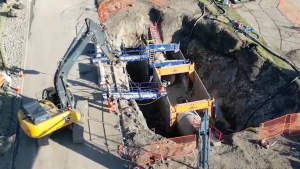Testimony from a senior Ministry of Labour, Training and Skills Development (MOL) policy manager on day three of Ontario’s swing stage inquest Feb. 2 revealed the ministry may be recommending changes to Working at Heights (WAH) training as soon as April.
William Roy, director of the strategy integration branch with the ministry, discussed “suggestions” for training reforms contained in a February 2019 Institute for Work & Health (IWH) report commissioned by the ministry during cross-examination by Building Trades counsel Craig Flood.
Roy said the 2019 report and a follow-up from 2020 will be considered along with other sources such as coroners’ juries’ recommendations as the ministry publishes a five-year review of WAH training this spring.
The inquest, being conducted virtually, is investigating the cause of the deaths of Metron Construction site supervisor Fayzullo Fazilov and workers Vladimir Korostin, Aleksey Blumberg and Alexander Bondorev, who fell 13 storeys on Christmas Eve 2009 when the swing stage they were on collapsed at a Toronto jobsite.
An agreed-upon statement of facts identified substandard fabrication of the swing stage and failure to use a fall arrest system as causes of the fatalities.
Where does WAH training go from here?
WAH training was introduced as part of a package of training and other reforms in 2015.
Roy said the WAH training program was an exceptional initiative and a world first.
“I think that Ontario, having done this, was the largest initiative where the private sector trained on behalf of the government in a standardized way,” he said. “We haven’t seen this model anywhere else in the world, and that has paid dividends as far as we can see.
“Although we have a good rate…we can always improve.”
The report found “consistent evidence that the training had an impact at the worksite.”
WSIB statistics indicated the decline in the lost-time injury rate for falls in construction between 2012-14 and 2017 was 19.6 per cent. Roy said a total decline of 25 per cent was reported in the 2020 follow-up.
Regarding training, the suggestions included recommendations that the MOL set measurable performance targets to reduce falls from heights; review successes and failures of different providers, given that there are over 200 providers in the province; and determine if there are more successful outcomes with some programs than others.
Flood went back and forth with Roy on the issue of retention of lessons learned in training. The lawyer noted it was found that two years after workers received training, they were observed to have forgotten or to not be applying the information they had received. Refresher training is scheduled every three years.
“They don’t revert back to the same level of knowledge (as the original baseline), they retain something but they’re losing information,” said Flood.
Roy responded, “I agree with that. But it’s not the decline in the workplace practices.”
The key is in acquired competencies, Roy said.
“When they looked at the practical applications in the workplace, do you continue to tie off, do you use the appropriate form of travel fall protection? Do you refuse work when it’s unsafe?
“All of those remained at a very high level,” he said. “We have empirical evidence. We have data that shows there is a regular continuous reduction in the rate.”
One suggestion from the report was to modify WAH training to require more hands-on practice setting up travel restraints. Roy acknowledged to Flood that the April report would recommend moving education about travel restraints from the theoretical to the practical side.
Do notices need a “nudge”?
Later MOL counsel Neil Gobardhan asked both Roy and fellow MOL witness Filomena Savoia the same question: “Based on your understanding of the current legislation, is there any gap in the regulation that you think could be filled by a practical legislative change?”
Both answered in the negative.
“I don’t believe so. Not with respect to this situation here today,” said Savoia.
At one point, under questioning from one of the inquest jurors, Roy expressed surprise when asked whether the MOL had considered a “nudge” element in notices submitted by employers of plans for suspended platforms.
“Are they required to check a box that says, ‘I swear that this has met the annual inspection, that this has been certified by the supplier or whatever, those checks, the detailed regulations?” asked the juror.
“That’s a fantastic idea,” said Roy, who had previously discussed the benefits of “nudge” questions to obtain more honest responses on tax forms.
“That’s actually a great point.”
The inquest continues.











Recent Comments
comments for this post are closed